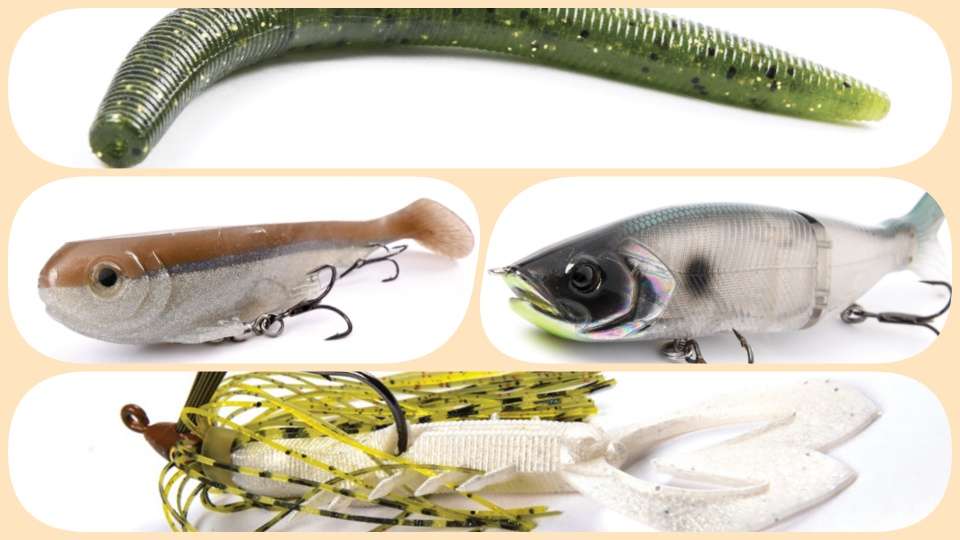
Along with its bouquet of colorful flowers, spring blossoms with incredible opportunities to tangle with enormous bass in various stages of the spawn. We’ve assembled a lineup of bona fide giant grabbers who share their tactics for fooling these spring whoppers.
Editor’s note: Land of Giants Fall | Winter | Summer | Spring
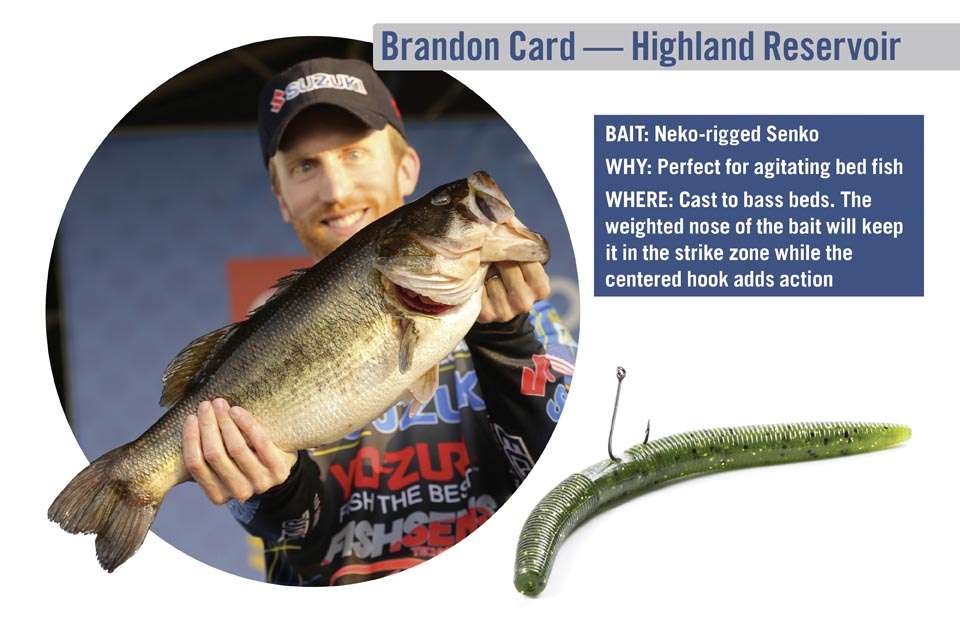
Brandon Card
On bodies like his Norris Lake home waters, the Bassmaster Elite Series angler from Tennessee knows that if a warm spring brings early spawners, the true giants will display deeply reclusive tendencies. Specifically, Card expects his greatest opportunities where most would overlook.
“In clear water, look deeper than the average spawning range,” he says. “If there are a bunch of beds in 3 to 4 feet, those big ones will be out deeper, where you can barely see the bottom.
“Also, they’ll be closer to the main lake — maybe on a secondary point, but not in the back of a pocket. I think a lot of those big ones spawn where people don’t look — in deeper and less obvious areas.”
Exemplifying big-bass stealth, Card notes that a lot of highland reservoir giants live in marinas year-round. They’ll move up to the nearest bank to spawn and then drop back to deep marina slips.
For the bed fish, Card’s confident with a Texas-rigged Yamamoto Craw or a Neko-rigged 5-inch Senko. However, if the fish have not made their move to the bank, he’ll look for staging spots with dingy water, good sun exposure and, most importantly, proximity to spawning areas.
“Those big ones won’t move far from where they’re going to spawn,” he says. “So, I would be fishing out toward the mouths of pockets and creeks and secondary points.”
Card’s top prespawn bait is a Yo-Zuri 3DB Squarelip — a 2 3/4-inch bait that gives hungry prespawners an enticing profile. In marinas, he’ll alternate between a weightless wacky-rigged Senko and a Yo-Zuri Pencil. Pinpointing casts into marina stalls and then slowly walking the bait across likely staging areas can yield thunderous bites.
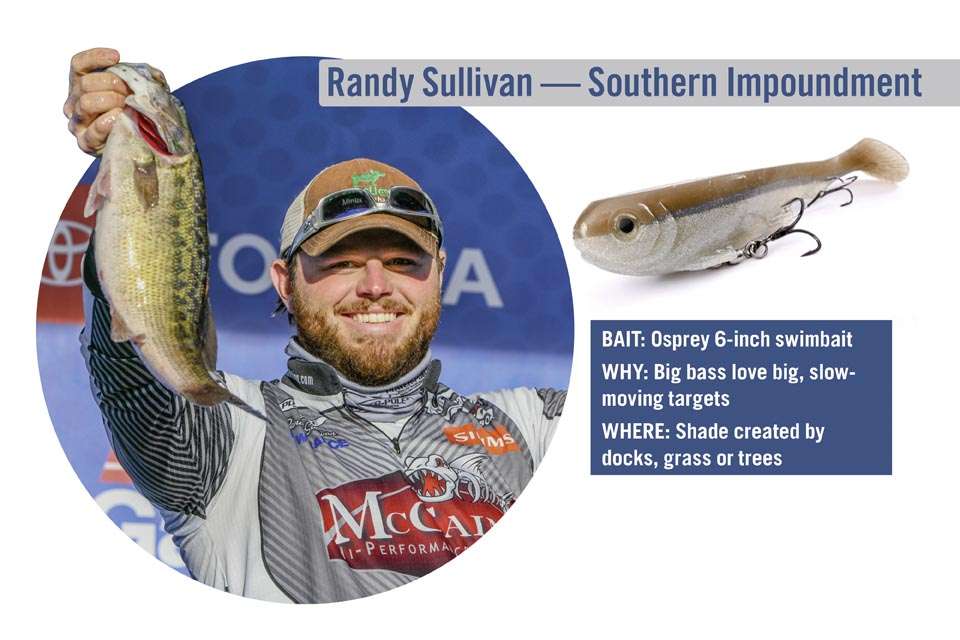
Randy Sullivan
In keeping with the “everything’s big in Texas” mantra, Elite angler Sullivan takes a straightforward approach to targeting giant Lone Star postspawners in major impoundments like Lake Amistad: Big fish want meals. They also want these belly-fillers in comfy, convenient scenarios, Sullivan explains.
“Those fish will key in on a certain type of [forage], like tilapia or big shad, and that changes how those big ones move,” he says. “If you look at the ShareLunker program [recognizes bass of 13 pounds or more caught and released], almost every one of them were caught on a slow-moving bait.
“I caught a 10-pounder in Texas and it was that same way; I had to crawl a worm incredibly slow and move it up and down, up and down, up and down on a tree limb until finally that one bit it.”
Specific postspawn habitat will vary by location, but Sullivan stresses the absolute essential element: shade. Docks, overhanging tree limbs and matted grass all fit the bill. And even more than the big worm, Sullivan loves a 6-inch Osprey in-line swimbait.
“This is swimbait heaven for big, giant ones,” Sullivan says. “I throw it around those shady areas when the sun comes out and just slow roll it. I’ve had some absolutely phenomenal days doing that.”
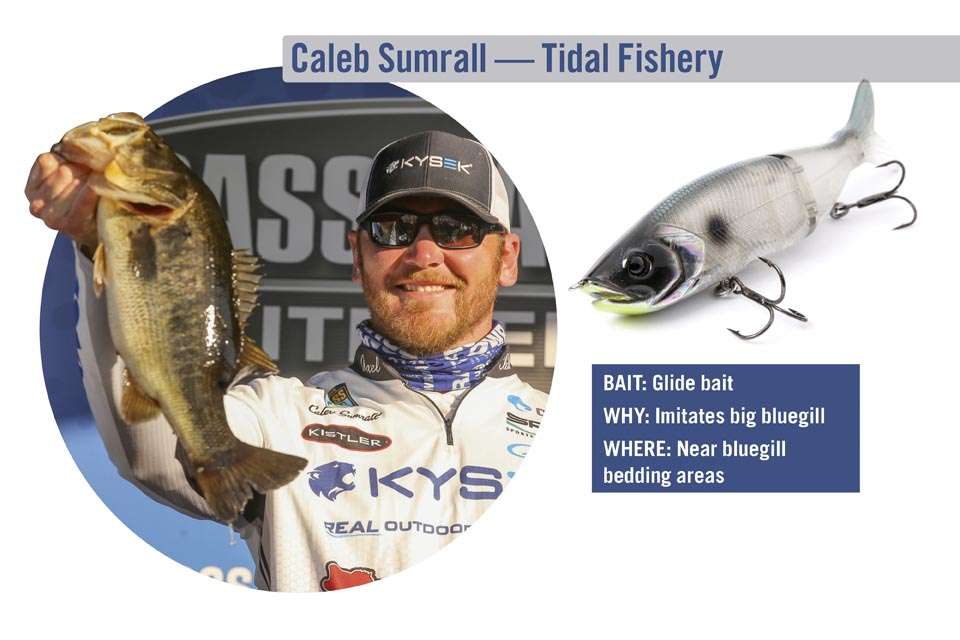
Caleb Sumrall
April may find many of the Bayou State bass in postspawn mode, and Sumrall capitalizes on the fact that big females will be looking to regain the calories lost during the bedding ritual. This, he said, is the time to target bream beds — but not just any bream.
“I want to find those fish that are eating palm-sized bluegill,” Sumrall says. “Normally, when the bream start bedding in a tidal fishery, there are always some fish that stay around them. In this scenario, the fish don’t have ledges to go set up on, so they stay around those bream most of the year.”
Noting a key point about tidal fisheries, Sumrall said the bream can’t set up beds in the backs of pockets like their lake brethren do because falling water would pull them out of the area. That means they have to spawn around outer structures, like cypress trees or old docks, which hold sufficient depth and provide current breaks.
When he finds the right setup, Sumrall tempts these bream-busting giants with a trident of mouthful baits. He’ll start with a 7-inch glide bait; and while a bluegill pattern is most intuitive, he’s also found gizzard shad to be a productive look.
“You’ll get very few bites, but when you do, it’s going to be a big one,” Sumrall says.
Approaching on a wind drift for maximum stealth, Sumrall hits his targets with multiple casts. If the glide bait fails to impress, he follows up with a 3/4-ounce to 1-ounce spinnerbait with No. 6 willowleaf blades and a skirt bearing orange and purple accents. The deal closer is a bladed jig carrying a 4.25-inch Missile Baits Shockwave swimbait in white, green pumpkin or black/blue.
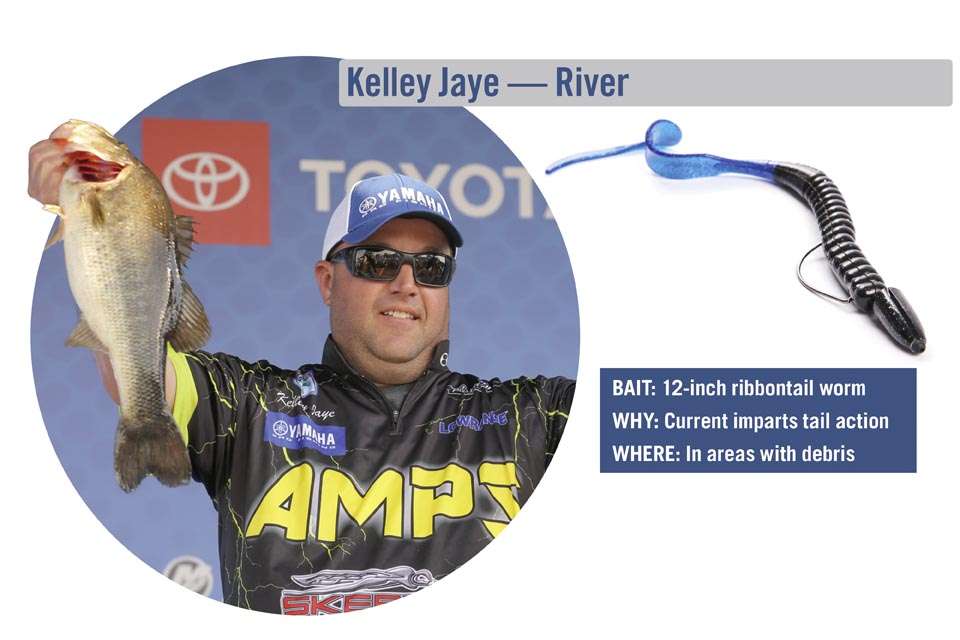
Kelley Jaye
In a prespawn or even a postspawn deal, the Elite angler from Alabama wants to locate the biggest concentration of baitfish. Backwaters, eddies, river bends — the buffet will always attract the jumbos, which prefer the easy pickings to chasing down a few at a time.
“If I’m looking for a true giant on a river with current, I like throwing a 1-ounce spinnerbait with No. 7 willowleaf blades,” Jaye says. “I like a white or chartreuse/white skirt, and I don’t run a keeper hook on a spinnerbait because I like a swimbait on the back of it.
“I’ll let the current carry it down, and I’ll just keep tension on the line. I’ll throw upstream and let the current pull the bait through the area.”
After thoroughly probing the water column with his spinnerbait, Jaye sends in a 3/4-ounce football jig with a craw trailer or a twin-tail grub. Black/blue is usually a good color for river habitat, but he goes with green pumpkin for exceptionally clear water.
In areas of heavy brush and debris, he’ll switch to the narrow head of an Arkie-style jig. With either jig style, the presentation style is called “washing” — a current-born descent similar to that of the spinnerbait.
Once he’s worked the area with a jig, Jaye cleans up by dragging a Texas-rigged 12-inch ribbontail worm. Pegging a 1/2-ounce tungsten weight keeps the rig efficient.
“The worm doesn’t have a lot of resistance, so you don’t need a 3/4-ounce weight,” Jaye says. “You want the current to make that tail work; you want the current to do all the action.”
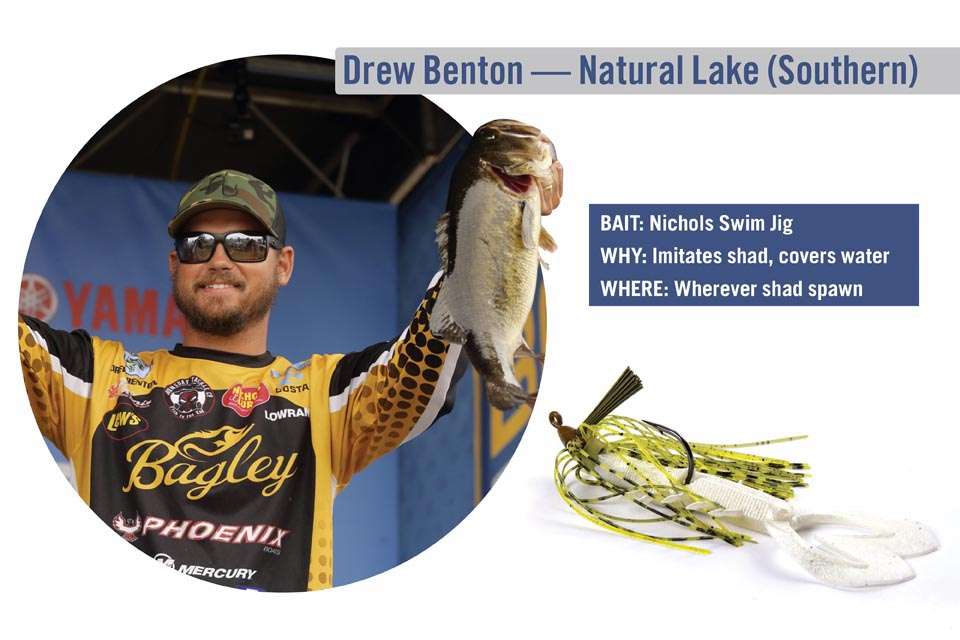
Drew Benton
Benton says shad spawns are a big deal in April, as fish reaching their postspawn phase are gorging on the vulnerable baitfish. The giants start early, so don’t be late to the party.
“When the water’s in the 70s, first thing in the morning, shad are spawning on docks, laydowns, lily pads, hard-clay points, riprap,” Benton says. “You just look for the birds on the bank or the shad flickering and key on those areas because your biggest fish will be feeding on those shad in the first hour after daybreak — longer if it’s cloudy.
“If you don’t capitalize on that, those fish will hang around those areas all day. They might move farther out to a grass point or slide out deeper, but they’re going to be in position to feed again on spawning shad the next morning.”
During shad spawns, Benton throws a white Nichols Swim Jig with a white Doomsday Devastator craw trailer. His top presentation: swimming through grass and around docks.
“You want to keep your rod tip up and keep the bait close to the surface,” Benton says. “You want to pop it kind of hard because you want to imitate one of those shad flickering on top. Work it fast because those fish are really keyed in on the shad, so you don’t want them to get a good look at it.”
When the morning bite wanes, Benton often looks to marinas and throws a Bagley Knocker Bee into the bays, where a quick cadence often brings fish charging from beneath docks. If they won’t come upstairs, he’ll drop a 6-inch flutter spoon into the shaded marina depths.
“I always like to put a feathered hook on the spoon,” Benton says. “It adds to the action, and it gives them a target to bite.”
Originally appeared in Bassmaster Magazine 2019.





